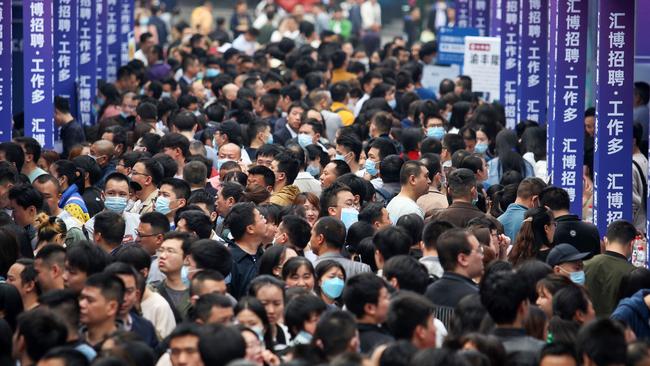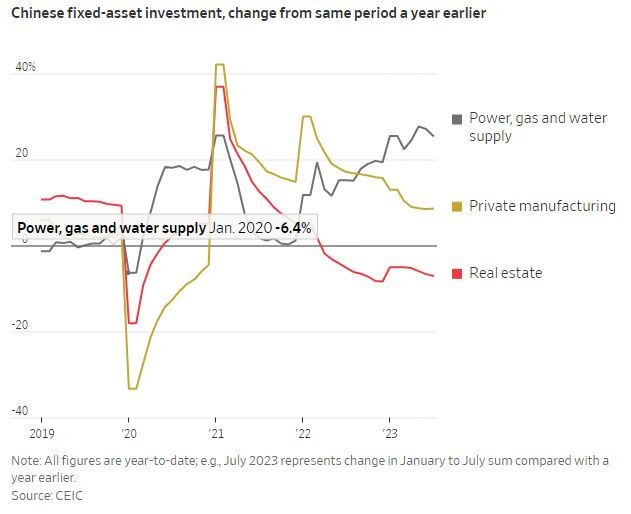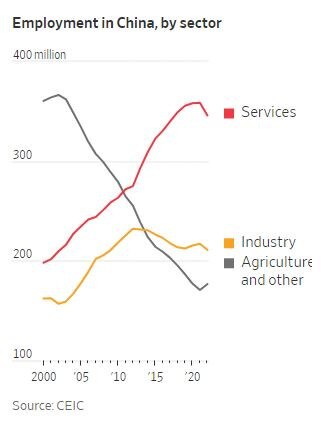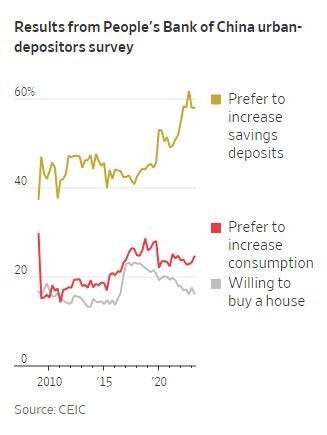China’s crisis of confidence in six charts
Chinese households are losing faith in the nation’s future, and this could drag down the entire economy.

What ails China?
There are plenty of answers, from demographics to geopolitics to trade. But the key problem might boil down to household finances and, just as important, everyday citizens’ deeply shaken confidence that their lives will keep improving following China’s Covid-19 emergency.
Why look at households specifically? China has a serious debt and productivity problem, especially in the state-owned and local-government sectors, but that has been true for years.

Exports are falling, but China has weathered trade downturns before. Moreover, private manufacturing and infrastructure investment are actually holding up relatively well.
What is really new and notable about the current slowdown is a combination of exceptionally weak consumer prices, consumption, services-sector investment and property investment. All of that points firmly at households.
Reduced willingness to spend and take risks by families also undermines other parts of the economy in pernicious and self-reinforcing ways: consumption directly, and investment indirectly because household borrowing, mainly through mortgages, has long helped keep cash-strapped property developers and local governments above water.

The shift to thrift

Chinese household debt, primarily mortgage debt, has risen so rapidly over the past decade that, as a percentage of disposable income, it is now approaching pre-2009 U.S. levels according to some analysts.
But there is a critical difference with the precrisis U.S. — China isn’t facing a tidal wave of mortgage delinquencies. Instead, households are paying down mortgage debt rapidly and retrenching financially in general. This rise in risk aversion has many causes, but several of Beijing’s key policies during the pandemic probably contributed — especially the three-year spell of “zero-Covid” policies that damaged the services-sector jobs engine and the crackdown on property-developer leverage that forced developers to delay the delivery of “presold” houses to families.
Getting stiffed

The key thing to understand is that Chinese households are actually giant lenders to a linchpin of the economy: property developers. About 90% of homes sold in China in 2021 were “presold,” meaning developers sold families rights to yet-to-be-built apartments.
In essence, Chinese households took out interest-paying mortgages — and then passed on that cash, interest-free, to property developers in return for apartments that didn’t yet exist. Property developers in turn fill local-government coffers by purchasing land for development.
To fully appreciate what a bad deal this was, consider that mortgage loans in China also tend to be “recourse.” That means if home buyers walk away, banks can still go after their other assets.
When big, financially stressed developers such as Evergrande began defaulting on these obligations to households in 2021, buyers responded by abandoning the market and paying down debt. Individual residential mortgage debt outstanding actually fell outright by 200 billion yuan, or about $28 billion, in the first half of 2023.
Hard times in the job market

To make matters worse, the housing crisis came as the economy’s key job engine — the services sector — was already under threat from Beijing’s “zero-Covid” policies and a regulatory crackdown on the internet platform economy, which, according to some estimates, accounts for about a quarter of urban jobs.
The services sector, which until 2020 had accounted for all the net job growth in China since 2012 and absorbs most highly educated graduates, shed a net 12 million jobs between 2020 and 2022, according to official figures. Strong exports helped paper over the cracks for a while, but as China was finally reopening in early 2023, the pandemic-era export boom was reversing. As a result, China entered the second quarter of 2023 with deeply wounded service and construction sectors, and a manufacturing engine threatening to stall out. The job market has struggled to find its footing, and a record coterie of new college graduates — many of whom fled the 2021 and 2022 job market for higher education — has pushed youth unemployment over 20%.
Crisis of confidence

The battered job and property markets have translated into pervasive pessimism: Households are saving at much higher levels than before the pandemic and expressing deep scepticism about further increasing consumption or buying a home.
A long-running survey of urban bank depositors by the central bank found that about 58% of respondents indicated a preference for boosting savings deposits in the second quarter, slightly down from December 2022’s 62% but up close to 15 percentage points since mid-2019. Only 24.5% were inclined to boost consumption.
Actual growth in savings deposits remains high, too: above 15% on a three-month annualised basis, according to the research consulting firm Gavekal Dragonomics. That compares with a pre-Covid average pace of about 10%.
Breaking the downward spiral
China’s economy is still growing, and incomes — for those with jobs — are rising. But as long as China remains stuck in a negative feedback loop of failing developers, falling home prices and skittish households, it might be difficult to arrest the economy’s slide.
That risks pessimistic expectations becoming firmly entrenched, in turn prompting even higher saving and an economy with less momentum. It could also trigger larger problems in the financial system as developers and local governments — and their bankers — struggle to fill the hole in the financing ecosystem left by retrenching households.
To break the feedback loop, the central government probably needs to flex its own balance sheet with big fiscal transfers to households, or indirectly bail out property developers — and reverse course on some of the aggressive regulatory measures that have alienated foreign investors and some domestic entrepreneurs.
But it remains unclear if Beijing will take such steps. For one, Beijing might be wary of big direct spending because its effective liabilities — in the form of local government debt — are substantial. Having invested so much political capital painting housing speculation, tech moguls and dependence on foreigners as social maladies in recent years, an explicit reversal now could amount to a significant political risk: in essence, an admission that more of the central leadership’s signature policies have failed.
The Wall Street Journal







To join the conversation, please log in. Don't have an account? Register
Join the conversation, you are commenting as Logout